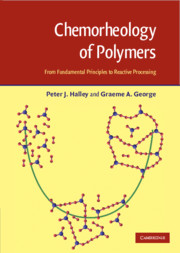Book contents
- Frontmatter
- Contents
- Preface
- 1 Chemistry and structure of reactive polymers
- 2 Physics and dynamics of reactive polymers
- 3 Chemical and physical analyses for reactive polymers
- 4 Chemorheological techniques for reactive polymers
- 5 Chemorheology and chemorheological modelling
- 6 Industrial technologies, chemorheological modelling and process modelling for processing reactive polymers
- Glossary of commonly used terms
- Index
6 - Industrial technologies, chemorheological modelling and process modelling for processing reactive polymers
Published online by Cambridge University Press: 14 August 2009
- Frontmatter
- Contents
- Preface
- 1 Chemistry and structure of reactive polymers
- 2 Physics and dynamics of reactive polymers
- 3 Chemical and physical analyses for reactive polymers
- 4 Chemorheological techniques for reactive polymers
- 5 Chemorheology and chemorheological modelling
- 6 Industrial technologies, chemorheological modelling and process modelling for processing reactive polymers
- Glossary of commonly used terms
- Index
Summary
Introduction
The aim of this chapter is to describe a range of industrial processing technologies for reactive polymer systems, and specifically to
characterise the process and highlight important processing-quality-control tests, process variables and typical systems used,
highlight applications of chemorheology in the process and
examine the use of chemorheology in modelling of the production process.
In this way we will be bringing the concepts and understanding from all subsequent chapters into practical processing applications in order to aid acquisition of deeper understanding of these processes.
Casting
Process diagram and description
Casting is a relatively simple process (Figure 6.1) involving the pouring of a thermosetting liquid into a mould, where the liquid hardens into a solid, dimensionally-stable shape.
Examples of products include rod stocks, spheres, gears, bushings and complex moulded items. In casting applications structural properties such as hardness, toughness, dimensional stability and machinability are of most interest.
Quality-control tests and important process variables
Important process variables include
cost
viscosity
reaction exotherm
shrinkage
pot life
Cost is typically reduced by minimizing the amount of resin used (either via incorporation of fillers or modifiers, or by foaming). Viscosity is critical for casting operations, in which requirements concerning ease of processibility and large loadings of fillers need to be optimized. Exotherms typically pose processing problems for large casting masses since the cure reaction evolves >100 kJ/mol (Section 3.2.2), which may be reduced by incorporation of fillers, modifiers and the correct curing agent at an optimum concentration.
Information
- Type
- Chapter
- Information
- Chemorheology of PolymersFrom Fundamental Principles to Reactive Processing, pp. 375 - 434Publisher: Cambridge University PressPrint publication year: 2009
